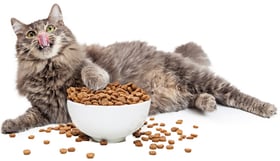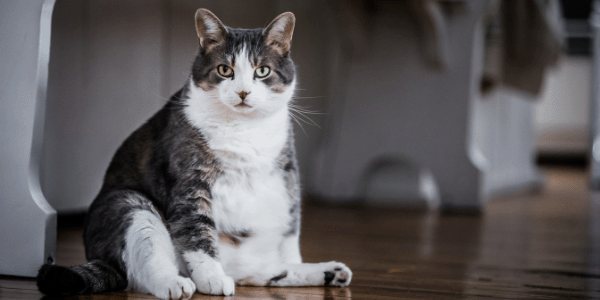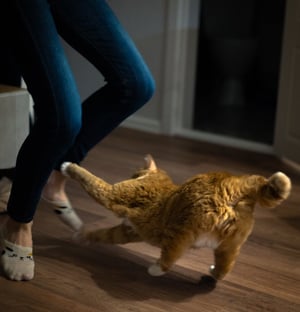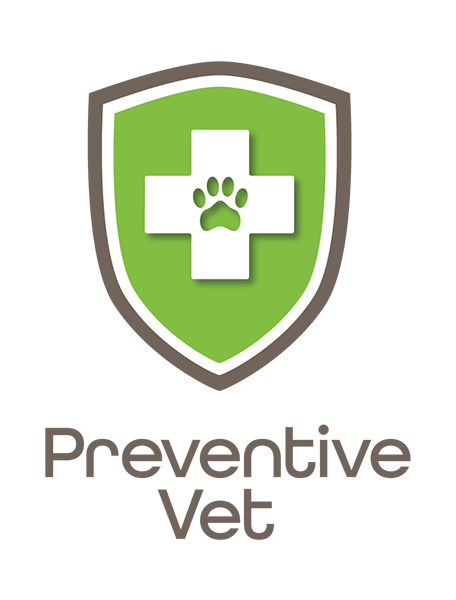- en
Your cat is packing on some extra pounds. Don't worry, they can be an ideal body weight again with a little bit of extra effort and a whole lot of patience on your part.
This pet information prescription will help you know what to do, how to help your cat transition to an ideal weight safely, and how to prevent weight gain from happening again in the future.
Quick Links

Nearly 60% of the cats in America are overweight or obese. With both conditions, excessive body fat causes inflammation. This inflammation can lead to lifelong diseases such as diabetes, heart disease, hypertension, arthritis, and many others.
Even before these diseases develop, overweight and obese cats can struggle with normal day-to-day activities, like grooming themselves properly, and they can start having litter box issues because of their excessive weight.
Our mission is to help save dogs' and cats’ lives through our educational content. To support our efforts, this page may contain affiliate links. We earn a commission for qualifying purchases – at no cost to you.
Cats are considered overweight when they are 10–20% above their ideal body weight. Obese cats are 20% or more above their ideal body weight. Obesity is the most common disease among domestic cats.
Common symptoms of being overweight or obese include slower or painful movement, labored breathing, poor grooming habits, sleeping more than normal, and an overall decrease in activity.
Left unchecked, overweight and obese cats can develop lifelong diseases, including diabetes, liver disease, arthritis, heart disease, and more. In addition to being uncomfortable in their daily lives, your cat's lifespan may be shortened.
Weight gain occurs when cats consume too many calories and don't exercise enough to burn these calories off.
While there may be some breed, genetic, and sex (spayed vs unspayed) predispositions, becoming overweight or obese is most commonly a result of being fed too much. Very few cats will self-regulate how much food they eat. As a result, it's important that you feed a measured amount only at mealtimes (avoid having bowls out all the time), account for the calories in treats, and make exercise a part of your cat's daily routine. Recent research has proven that cats need to be fed in ways that mimic their natural behavior — hunting their food — and having frequent small meals can help keep cats at a healthy weight and avoid a host of other problems.
Occasionally, weight gain can be the result of a medical condition like diabetes. If your cat has other symptoms (particularly if they are drinking more, urinating more, or vomiting), your veterinarian may recommend some diagnostic tests to rule out any other conditions.

Your veterinarian will advise you on your cat’s ideal weight as well as their weight loss plan. This will likely involve diet, exercise, and addressing any underlying medical conditions.
Managing your cat’s diet is key – eliminate treats, feed only the type of food recommended by your veterinarian, and be sure to measure your cat’s food to ensure that you’re giving the right amount and no more. It’s easy to “fill a bowl” and leave it out, but cats on a weight loss journey should be fed specific meals of a specific amount – such as 1/4 to 1/2 cup of food twice a day. Get a good measuring cup, and make sure everyone in your household knows the importance of your cat’s weight loss, so they’re not sneaking in treats!
Another option is to get an automatic feeder that dispenses a set amount of food for the day at intervals that you can preselect. Therefore, you are not tempted to give extra food and won’t have the worry about measuring the amount of food for each serving.
*NOTE* If you have a dog, do not leave out free choice food because your cat may decide to supplement themselves and eat the dog food! Calories are calories!

Exercise in cats is a little more tricky than it is with dogs, but it is still possible! Getting a cat to exercise is as easy as getting them to follow you from room to room (up and down stairs is best), playing/fetching with toys, chasing a laser pointer, or even purchasing an exercise wheel. Some cats can even be taught to walk with a harness and leash. Some people find using puzzle feeders or hiding their cat's bowls in different spots every day as a great way to increase exercise and satisfy their cat’s natural hunting instincts. Check out these ideas for interactive feeding.
Using a water fountain instead of a bowl for water has been found to make cats drink more frequently. This not only adds in their hydration but can preoccupy your cat and likely distract them from wanting food.
It is also important to weigh your cat at home (monthly and use the same scale each time because each scale is calibrated differently) and keep a journal of their weight history. You will need to alert your vet if there are any drastic changes in weight. Simply hold your cat on the scale with you and then subtract your weight after putting the cat back on the floor. This will give you your feline’s weight. If you don't have a scale at home, you can drop by your vet for a "weigh-in" using their scale. Always use the same carrier each time you bring your cat so that your cat doesn’t have to be taken out of the carrier. This way, the process of weighing is faster after the initial check because you already know the weight of the carrier. Be sure not to add or use different blankets each time as well. You can use a sharpie to write the carrier weight on it.
Luckily, most overweight cats are not in a lot of pain. However, for some, the increased strain on their joints may be uncomfortable. Start small with exercising for just a few minutes a day, and over time build up to longer periods and more frequent sessions. If your cat is agreeable, you can ice the areas that appear sore or stiff for about 20 minutes. Put the ice in a plastic bag and wrap it in a towel. Do not put the ice directly on your cat's skin. Your veterinarian can also recommend supplements that may help ease some of the pain until your cat decreases their weight.
Keep litter boxes accessible to avoid any accidents. Be sure that it isn’t a struggle for your cat to get in and out of the litter box, as well as make sure it is big enough in size to accommodate them. Converting an extra-large storage container with a lid into a litter box works great. Cut an opening on one side that is low enough and wide enough for your cat to be able to get into the box easily. Place about 2 inches of litter throughout the box.
Increase their physical and mental stimulation to distract them from not getting to eat everything they want to! For example, create a shelf they can climb to, with only mild effort, to look out a window. Bird watching and people watching can be a great distraction. There are also specialty cat cages that you can set up to give your cat outside time in a safe and protected manner if you have a yard.
Your cat will definitely notice the decrease in calories and might act like they are starving all of the time. To prevent any "hangry" behaviors, eating their meals too quickly, meowing, try these tricks:
Once you hit that goal weight, don’t slip back into old habits – keep your cat at their ideal body weight! This will decrease the risk of certain lifelong diseases. Remember, you should be able to feel your kitty's ribs!
Note: All cats have a fat pad on the underside of their belly. Even if your cat loses weight, they may always have a pouch of fat below the belly area. Don’t stress over it!
If your cat’s weight is gradually dropping by a few ounces every week, you are doing a great job!
Your cat should start to become more lively, especially if they were before they gained the extra weight. Losing weight is often like losing years off their age.

If your cat has not lost any weight in 6–8 weeks of exercise and calorie restriction, you should consult your veterinarian. Your vet may recommend some diagnostic tests to find out why your companion is not losing weight, or recommend a different diet (even a prescription-strength diet if necessary).

The best prevention is to keep your cat on a regulated feeding schedule with a diet that is appropriate for their age and activity level, to maintain a lean weight, and to keep them active and curious!
The Pet InfoRx® is made possible, in part, through our partnership with AlignCare®.


© Preventive Vet. All rights reserved. PreventiveVet.com
